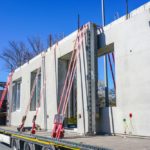Sector - Software & Technology
Surveying and construction: five key predictions for 2023

It is no exaggeration to say that 2022 was hugely eventful, heralding major economic, political and business changes with far-reaching implications. If we look at construction, and the surveying that underpins it – two sectors that are closely interlinked – the evolution of both is driven by several key trends and factors. Stephanie Ellrott, Sales & Marketing Director at Plowman Craven, looks at the year ahead and what we can expect to be the main focus areas?
An urgent ramping up on net zero action
Despite the pledges of the previous year, COP27 showed little progress, with a UN report noting that carbon reduction plans and actions have so far been “woefully inadequate”. According to RICS findings, the built environment is responsible for around a quarter of the UK’s carbon emissions and, with targets to cut emissions by 68% by 2030 (compared with 1990 levels), there is recognition that current policy and measures are not enough. Lowering ambitious climate goals that may now seem unrealistic is not an option; instead, in 2023, we’ll feel an urgency like never before and can expect government action to increase.
Contractors will focus not just on lowering energy demand on sites pre and during construction but also on operational energy efficiency, from the earliest stages. Monitoring can play a big part here, supporting leaner designs (i.e., fewer materials with high embodied carbon, such as concrete and steel), evaluating tolerances, managing the risks of using thinner concrete and decreasing the number of props needed.
A bigger shift towards renewables
There is likely to be a more determined move towards renewable energy, in line with the UK’s Energy Security Strategy and decarbonisation efforts. Many construction sites already started shifting away from diesel generators and machinery to those powered by renewable energy sources like wind and solar. The adoption of off-grid battery storage systems and hybrid power, as well as green hydrogen, will rise.
Monitoring also holds much potential for incorporating renewables, and it’s something we have seen in action when our team powered a whole six-month project – comprising air quality, dust and noise monitoring in London – using solar and wind energy. These systems will mature to become more economically viable as they enter the mainstream and as climate-related policy tightens.
Reuse and refurbish – not demolish
Property will be more likely to be refurbished than demolished. There is much debate surrounding the pros and cons of each (think of the M&S building at 1-4 Marble Arch, where questions arose on whether demolition would make more sense from a carbon perspective). However, bearing in mind that the UK’s construction and demolition industry contributes more than 60% of all the waste generated, retrofit should more often than not be prioritised as the more sustainable option. It opens up opportunities to recycle considerable amounts of materials rather than starting from scratch, creating better operational and cost efficiencies (a boon given the current macro landscape and materials costs).
Major infrastructure projects in the pipeline
Infrastructure remains high on the agenda, particularly nuclear (a way to bolster the UK’s energy security and mitigate energy price instability stemming from the Ukraine war), road and rail. Based on the last Budget, the fact that capital spending is not keeping pace with inflation could delay certain other plans to enable the likes of Sizewell C and HS2 to be finished. Despite economic pressures, more investment needs to go to water and sewage infrastructure for greater resilience – critical given that most of our waterways are contaminated, with regular reports of sewage spills. Heavy rainfall is on the rise due to climate change, overwhelming storm overflow systems that were not intended for such extremes. More legislative updates, such as Schedule 3 of the Flood and Water Management Act (new standards for sustainable drainage systems) may come into effect.
Plowman Craven worked on the Thames Tideway Tunnel, completing this year – the UK water industry’s largest ever infrastructure project, it’s designed to connect sewer overflows to keep sewage out of the Thames. The process of identifying the best locations for new vents and shafts was facilitated by 3D topographic and underground utilities surveys and, for upgrades to infrastructure more widely, surveying and mapping can provide full visibility of capacity and uncover where improvements are needed. For instance, the Secretary of State for Transport said in 2022 that it was clear when he was appointed that our railways were “desperately in need of modernising and reform.” That’s where developments in drone technology can enable accurate aerial surveys and expedite positive change.
Smarter data management models
Digitalisation will continue to accelerate, and we will see the advent of increasingly intelligent information models. Building Information Modelling (BIM), and its applicability in construction, will grow and, as it moves from 3D to 4D and up to 7D, will benefit from additional game-changing capabilities for harnessing data sets. It can help with longer-term models and optimised data management, boosting productivity, generating valuable data-led insights and conducting more accurate whole lifecycle assessments. Further, it creates common data environments to maximise collaboration across teams.
Construction, like most industries, will be affected by cutting-edge AI and machine learning technologies reaching new heights and offering faster and better data analytics solutions. These trends will also propel surveying forward, through sophisticated data capture methods, something we are already seeing with hand-held 3D laser scanning equipment that translates seamlessly into software platforms.
If you would like to read more stories like this, then please click here
Related Articles
More Software & Technology Features
- £115M lost to cyberattacks
28 Nov 25
Small construction firms lose over £115 million to cyberattacks annually, making it the UK’s third-most financially impacted sector, according to a new study.
- Small Builders, big wins: Practical Artificial Intelligence that speeds up UK Construction Operations
12 Sep 25
Practical advice where artificial intelligence can return time and protect margin for smaller UK contractors.
- Alternative building practices are crucial to unlocking AI infrastructure benefits
7 Mar 25
With AI capabilities developing at an unprecedented pace, the government has announced its AI Opportunities Action Plan.






